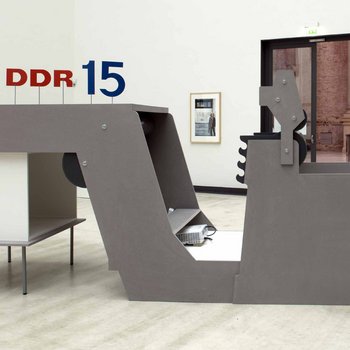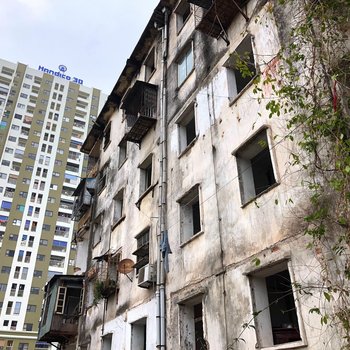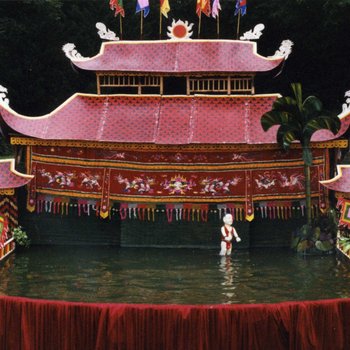The series that I propose is a collage of many stories and destinies of the Vietnamese people through variegated spaces and times, from the adhere socialist ideologist era to neo-liberal cities that are both
intertwined and challenged with traditional customs and beliefs from the pre-industrial period. In such milieus, East Germany (GDR) appears at times boldly, at times subtly, or sometimes as a distantly correlated premise for social comparison and reference. What connects these two countries are perhaps the remnants of a displaced ideology.
Arlette, thank you very much for taking the time to speak a bit further on how you put together the selection of films for “voices” in the context of a digital screening program relating to the research and exhibition project “Revolutionary Romances. Transcultural Art Histories in the GDR.” I approached you with the very wide topic about the relations between the GDR and Vietnam. Can you share how you started your selection and how you unfolded the topic.
Usually when it comes to the relationship between two countries, people will think immediately of the stories of people-to-people networks that move between the two countries. However, I prefer to observe first the spaces and landscapes that surround the people, because places and people's customs intersect, collide, shape each other, at the same time, overlap, fight and resist each other. In the landscape and space, the people it contains expose their behavioral and cultural characteristics through surface textures. It reveals the rhythm and nature of the activities of the community there, and as such, the surface textures of the landscape tell the community's grand narrative. For example, you must have been to Dong Xuan Center - a buzzling Asian market of the Vietnamese in the Lichtenberg district of Berlin. I usually went from the Mitte area near Alexander Platz, then took the M8 tram to the market. Before you hear the noise of people conversing Vietnamese, smell the aroma of bún chả (grilled pork vermicelli), or see the colorful patterns of the goods, perhaps you notice a change of the landscape when approaching the tram station. The urbanscape changes dramatically from Berlin Mitte’s “Altbau” architecture to Karl-Marx-Allee or the Platz der Vereinten Nationen's “Sozialistischer Klassizismus” to “Plattenbau,” and the to the large warehouse-lookalike market halls in Lichtenberg and Marzahn. Such changes are always dynamic, overlapping, eradicating, moving what already exists. These architectural and urban planning appearances are the witness and vestiges of historical changes. They make visible the intersection between politics, migration and economic pursuits. Unobtrusively, the characteristics of an architectural ensemble can unfold the intersubjectivity of the individuals in it.
So, when I think about the relationship between GDR and Vietnam, I want to see it in a way beyond the authenticity of origin, so apart from pure nationalism. I hope to find a view that gives context, but doesn't reduce it to a distinctly political, social, or racial motif. I look for connections or relationships that are indiscernible, even ambiguous. Like Ho Chi Minh - a Communist leader - repeatedly contacted President Harry Truman asking for American intervention in Vietnam to completely pull the French colonialists out of Indochina. Like the way the Vietnamese expanded, and adjusted the modern “Plattenbau” from Eastern Europe to the needs of their living and agricultural economy in the urban areas such as growing vegetables, raising pigs in collective housings. Like the ambiguous nature of the GDR-Vietnam solidarity agreement, between "Lehrlinge" - apprenticeship for technical training purpose - and "Arbeitskraft" - cheap labor export from a Third World country to Europe.
With that thought, selecting the works for the "voices" series is however not easy. I decided to choose the remnants of ideology as the main reference for the relations between GDR - a communist country that was wiped out - and Vietnam - where Communism unified the whole country but then mutated towards Party-controlled neo-liberalism. With that abstract thread, I sew together the phenomena that appear in domestic and public spaces and landscapes Vietnam and Germany today through moving images by filmmakers and artists from Vietnam and Vietnamese descent, in various forms of expression, from feature film like “We come into life” (2021) by Siu Pham, short film like “Jackfruit” (2021) by Thuy-Trang Nguyen, animations like Cardio (2022) by Nguyen Duc Huy and “Through the looking glass" (2022) by Nguyen Tran Nam and music video like “Sinh to 1" (2020) by Nodey.
How much of a topic is the GDR in everyday life in Vietnam? Maybe you could also go into how much of a divide is there in society still about South and North and their respective histories/identifications?
I think Germany is a very special case when it comes to discuss the overseas Vietnamese community. When the United States withdrew its troops from Vietnam and the North - South conflict ended in the first half of 1970s, the confrontation of the two superpowers in the Cold War changed to other battlefields. But for the Vietnamese, it continued in the division of migration flows into two different blocks: refugees from the 17th parallel southward were fleeing to the US, Australia, and Western Europe; and from the 17th parallel northward, many officially re-located to Eastern Europe and the Soviet bloc countries as foreign students or contract laborers. The Iron Curtain separating those two migrant communities exists to this day. But this division is shaken in Germany, when the country was unified. In the eyes of the Westerners, and in the population statistics, within one same seamless border, these two immigrant communities merge into one - overseas Vietnamese. And in Vietnam, after reunification, the flow of migrants from the North to the South increased significantly, in which, families with relatives in GDR moved to the South to live, among families whose relatives escaped to BRD. Then these familial relatives migrated later, or sent their children to Germany to study in both East and West Germany. The separation may be more pronounced in Germany within different Vietnamese German groups, because the living habits and ways of making a living among those who came from the South differ from Vietnamese who were from the socialist bloc. But in Vietnam, historical inheritances seem to fade when only the name of the unified country is called Germany, or Vietnam. At times, they come to life again at the reunions of fellow-countrymen abroad, of former international students or laborers in GDR, or in the display of solidarity anti-imperialism posters at the War Remnants Museum in Saigon.
I know that you studied in Berlin, but also in Vietnam and in the US, and you’re working as a curator in different contexts. What differences do you see in the academic approaches to art history or rather the social art history, and how can this be relevant for the post-socialist contexts of East Germany and Vietnam?
In the last nearly two years, I have been a curatorial advisor to the curator team of the 58. Carnegie International, led by my friend Sohrab Mohebbi. We've talked a lot about the "geopolitical footprint" of the United States in the world since the end of World War II, with particular attention paid to underground flows where standpoints of the actors were indistinguishable. Sohrab names the exhibition very interestingly: “Is it morning for you yet?”. He said “When it is morning for some, it might still be night for others”. Indeed, ambiguity is perhaps a characteristic of many small countries dominated by this Cold War. When it comes to post-socialist contexts, in your question, it's between East Germany and Vietnam, not East Germany and North Vietnam. Which Vietnam is this? Northern Vietnam which had ties with the GDR? Or the remix Vietnam nowadays? This ambiguity is not eclecticism, for in their overarching presence still emphasized the features of the consistent ideology. One must pay closer attention to the details of the surface. Broken lines, glimmering sprouts, things that are hidden from view, on the back of the surface, small gestures, which cannot be described straightforward into categories. One can only talk around, talk nearby about it.
The history of Vietnamese art known in the world is often recorded and written by foreign researchers or overseas Vietnamese who mostly come from the United States or Western Europe. Therefore, art discourses and exchanges focus on today's unified Vietnam, especially after the Doi Moi milestone, or the immigrant community living in the past anti-Communist bloc. Broken or forgotten intervals in art history include the art of South Vietnam before 1975. But even socialist realism is considered obsolete and outmoded for its state propaganda machine or degenerated into retro merchandise items.
Vietnamese art history needs to have less one-sided perspectives to revisit past aesthetic movements. What is taken for granted of the bright sky of ideology of GDR and Vietnam, may just be the front of a sketch that simply depicts a nude body imperturbably leaning against time.
I know that you have a special personal connection to the GDR as well – you were born in East Berlin, returned to Vietnam in the 1990s after the Peaceful Revolution and the reunification of Germany, and then returned to Berlin later to study. How is your relation to East Germany and how different is this to your parents’ who I suppose had a completely different experience?
Let me tell you about a bittersweet memory I come across. When I went to Germany and the US to study, I often had to fill out the forms where I was born. On my passport, it says “CHLB Đức”, the Vietnamese translation of Bundesrepublik Deutschland. When I wrote down ‘Deutschland’ or ‘Germany’, the officers often retorted that it was not my place of birth. They understood “CHLB Đức" as a funny name of a Vietnamese town. Ironically, they were right, I was not born in Budesrepublik Deutschland, but a country that has since been erased - the GDR. You see, it is sometimes difficult to officially inherit one's history.
What about my parents? After returning to Vietnam, they sought to flee their homeland Hanoi - the cradle of the Communist Party. They brought me to the South to live. I grew up in Saigon with friends whose relatives were all overseas Vietnamese in America and Western Europe. My parents were tired of the capital where all business relations must involve the State. But still they remember the Communist GDR as a free, innocent and romantic youth. They always talked about the story that the doctor and the local church tried to protect my mother from being deported back to Vietnam because pregnancy was a taboo when being sent abroad at that time. When I went to Germany to study abroad, my father told me to go to the hospital where I was born, to find the midwife who helped deliver me, to ask if she still remembered me, a special case existed in that disciplined situation - the baby with black hair and a completely different skin color from all others born in that hospital.

Also of interest:
In 2022 and 2023, Staatliche Kunstsammlungen Dresden are fixing their gaze once again on GDR times in their research and exhibition project “Kontrapunkte” (“counterpoints”), funded by the German Federal Cultural Foundation. Based on their own holdings and the history of their collection, fresh perspectives are being developed on art in the GDR, how it was seen and the significance allotted to it in the past and present, with the addition of international viewpoints. To this end, a range of physical and digital formats are in the pipeline, information on which will be provided on this platform.

The annihilation of Vinh City by US bomb raids offered an opportunity for experimental planning and for transforming the small industrial town into a model socialist city. The GDR’s ambitious task of comprehensive reconstruction involved working collectively on both the creation of a master plan and its realization in built form. Christina Schwenkel on the Quang Trung housing complex.

In the spring of 2020, a very special troupe of brightly coloured figures took up residence in the depot of the Puppentheatersammlung. Fishers and farmers, musicians and child gymnasts, not to mention ducks, water buffalos, dragons and fairies. They all belong to the classic cast of Vietnamese water puppetry.
